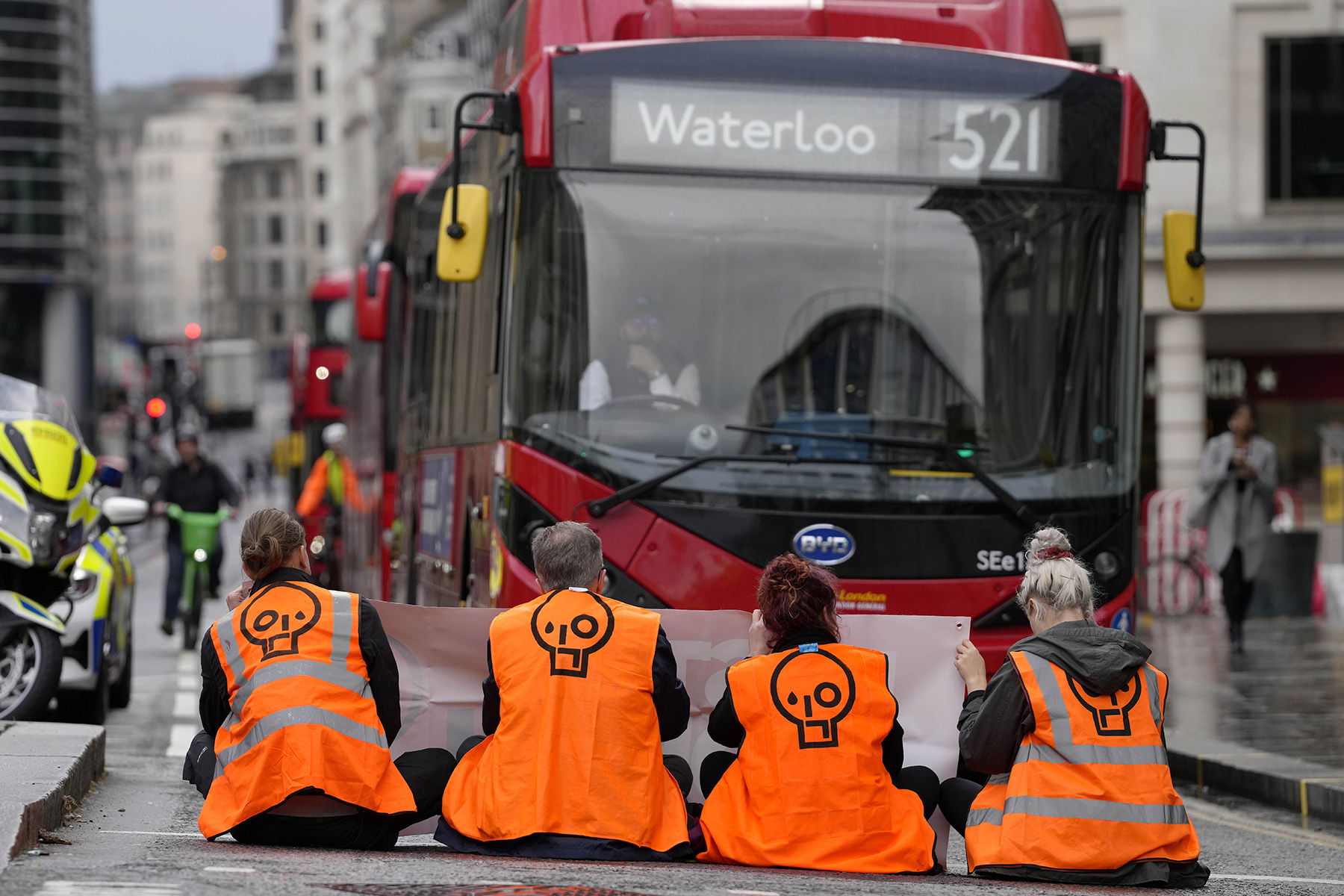”I am talking about the slaughter, death, and starvation of six billion people this century—that’s what the science predicts,” Roger Hallam, the co-founder of Extinction Rebellion and Just Stop Oil told the BBC in 2019.
The English word ‘genocide’ seems far too tame a word for such voracious, planet-wide human obliteration. Not the tens of thousands in Gaza. Not the six million of the Nazi death camps, but six billion. Perhaps even the end of the human race; certainly the end of civilization. Such cataclysm seems far better described by the word ‘omnicide’—the death of all humans.
And the climate omnicide does not begin decades away; it’s not an end-of-century phenomenon at three or four or five degrees of warming above pre-industrial temperatures that between now and then we might somehow be able to avoid. For Hallam, the omnicide is rapidly approaching. In late 2023, he held up a scientific paper to a different BBC reporter, saying that its authors had calculated that already at 2C of global warming, we should expect one billion people to be killed. And this paper is typical of what the science is telling us, Hallam insisted. There is ”nothing particularly unique about this.” He hasn’t cherry-picked a particularly grim outlier of a paper to scare us. This is, allegedly, the consensus.
Climatologist Zeke Hausfather writing for Carbon Brief noted in April that the first three months of 2024 had experienced average global temperatures of 1.6C above pre-industrial times. In 2023, the average global temperature pierced 2C of warming —although it was just for one day, the 17th of November. Temperatures fluctuate significantly from day to day, month to month and year to year, and so it is the overall decades trend, not such daily variability that we should be paying attention to. And, as of the time of writing, that overall trend tells us that we have seen roughly 1.3C of warming since the Industrial Revolution.
Nevertheless, this breach of the threshold, however brief, was disconcerting. And based on current rates of emissions mitigation, if policy does not markedly change in the coming years, the Earth is on track to persistently (rather than briefly) exceed 2C at some point between 2038 and 2072, with the median prediction placed at 2052. That’s just 28 years from now, as close to us today as 1996 and ‘Wannabe’ by the Spice Girls topped the charts. And the lower bound is a mere 14 years away. Hallam recently doubled down on his expectation of imminent doom, saying in May that 12 percent of humanity will die in the 2030s. The omnicide begins in six years’ time, he thinks. Indeed, its first calamities have already begun.
While in jail for four weeks, Hallam wrote a 12,000-word essay titled ”Advice to Young People, as you Face Annihilation”, in which he averred that climate change will soon destroy our ability to grow food, if it isn’t already doing so. With the breadbaskets of the world failing, the shelves of supermarkets will either slowly or rapidly be cleaned out and then, like a vision from Cormac McCarthy’s The Road:
”A gang of boys will break into your house demanding food. They will see your mother, your sister, your girlfriend, and they will gang rape her on the kitchen table. They will force you to watch, laughing at you. At the end, they will accuse you of enjoying it. They’ll take a cigarette and burn out your eyes with it.”
Luxuriating in his apocalyptic visions, he repeated his rape fantasy to the UK’s TalkRadio ”They take your mother, put her on the table and gang rape her, then they take a hot stick and poke out your eyes,” he said in 2022. ”That’s the reality of the annihilation project that you face.”
It’s not just Hallam who issues these eschatological prophecies. Cameron Ford, a spokesperson for Insulate Britain, a spinoff of Extinction Rebellion, told British left-wing columnist Owen Jones that ”societal collapse” is near, ”And then you see slaughter. You’ll see rape. You’ll see murder… We will lose everything we love.”
The conviction that we live in the End of Days is also not just an eccentric quirk of British activists. One of Germany’s most high-profile climate campaigners and co-founder of anti-coal-mining campaign group Ende Galände, Tadzio Müller, likewise has convinced himself that the clean transition ”is nowhere to be seen”. Sure, there has been some growth in deployment of clean energy technologies, particularly solar, wind, batteries and electric vehicles, he concedes in a recent essay in Flamman, but CO2 emissions continue to rise while banks continue to lend trillions to fossil fuel companies. A pair of floods that killed hundreds in Afghanistan and dozens in Brazil in May shows how that there is now ”absolutely zero chance of avoiding climate collapse”, if such collapse is not already underway.
Activists like him have failed utterly, he now believes. We must confront the reality that tipping points leading to runaway climate change are now unavoidable, Müller declares, and so we have to accept the brute reality that ”everything we’ve done, our type of ‘activism’ is kind of over.” In place of climate activism ”business as usual”, he prescribes prepping for the now certain apocalypse to come.
Müller stresses that this climate prepping will not be anything like the doomsday ”preppers” associated with the far-right survivalists and their bunkers full of filtered water, canned prunes and Spam. Instead he gives the example of the Swedish group Prepping Together, and argues for moving away from political struggles ”and more towards a needs-based politics.” This means construction of ”movement-based disaster relief networks” to buttress what remains of emergency services amidst floods and forest fires and heatwaves, so that the fire brigades, ambulances, paramedics and so on are not overwhelmed. When the supermarket shelves are empty and the state is no longer able or willing to enforce the law, ”vigilante groups” will form to enforce community rules. It is unclear whether he worries about the rise of such groups or advocates it.
Along the same lines, University of Tasmania human geographer Kate Booth and eco-activist Tristan Sykes coordinate a campaign platform called Just Collapse, that pushes for local groups to form to at least coordinate a just descent down from modernity. And the University of Cumbria’s Jem Bendell produced a widely influential essay in 2018, ”Deep Adaptation”, that similarly argues that climate-driven societal collapse is unavoidable in the near term, if it isn’t already underway, and so we must adapt to that reality.

Tied to all this apocalypticism is an abandonment in the working class as the agent of change. If there is no hope, then, contra Winston Smith, it cannot lie in the Proles. Many doomsters even evince an antipathy toward the working class, and especially industrial workers organized in unions, whom they see as siding with the fossil bosses. In a discussion with Swedish sociologist and advocate of eco-sabotage, Andreas Malm, Müller said that workers and trade unions need to be ”recognized as an enemy” in the fight against climate change and biodiversity loss. Japanese political scientist and ‘degrowth communist’ Kohei Saito believes Western workers in particular enjoy ”extravagant lifestyles” and so must be brought low, while German scholars Markus Wissen and Ulrich Brand tell us these same workers collaborate with capital to maintain their ”imperial mode of living.”
If the workers are no longer the revolutionary subject of history, or if they are now even the enemy, what force remains that can provide deliverance but the climate apocalypse itself? Rather than fearful of the End of Days, these prophets of doom secretly or openly wish for such a Book of Revelation-style cleansing, washing away the sins and sinners of industrial modernity.
They are praying for the climate Rapture.
Is the end really nigh?
Just as we have a responsibility not to minimize the threat posed by climate change, so too do we have a responsibility not to exaggerate.
We must not cherry-pick data or papers that confirm a conviction about the worst outcome being likely, and we must also know how to not engage in cherry-picking, how to try to avoid confirmation bias—our ingrained tendency to favour information that confirms our existing beliefs. We must consider the overall trends of natural disasters at a particular locality and around the world, comprehending the role of natural variability, and not alight upon single incidents. We must wait for what attribution scientists (the young field that assesses the contribution of global warming to various phenomena) conclude. We must familiarise ourselves with what those who have great experience in energy, transport, agricultural and industrial systems say about the likelihood and feasibility of clean technological change—from economists and engineers, to the workers in those systems who are often more familiar with them than anyone. And above all, we must not spin out manifestly false post-apocalyptic fantasias about empty supermarkets, vigilantes and rape gangs.
Those who say we should exaggerate in order to wake up all the ”sheep” are condescending and anti-democratic, assuming that ordinary people cannot comprehend the world around them in the absence of lies from their betters. It is also counter-productive: when those who do have expertise and experience in various sciences and industrial systems confront these lies, the green left in particular and the left as a whole is discredited. Exaggerations and lies about the end of the world are a gift climate deniers, who are happy to parade around these unhinged, baseless claims in order to discredit what climate science really does have to tell us. They are also a gift to fossil fuel companies, as they primarily act to demobilize: if nothing can be done, if we’re all doomed, why bother campaigning, protesting, voting for better policy, going to school to become a nuclear engineer, exploration geologist, infectious disease specialist or hydrologist (the sort of skills a warming world desperately needs more of), if there is no hope? Might as well party it up while there’s still time.
But even if such exaggeration and lies were not counterproductive, even if the doom-mongers were not acting as the useful idiots of deniers and oil companies, they would still be wrong. The evidence just does not support anything that they say.
When we consider the full breadth of what hundreds of papers and models have concluded about the state of emissions mitigation, we find a very different understanding than that of the doomers. When we look at how humanity has responded to past, often severe environmental challenges, and our experience with natural disasters over the centuries, we find that overall, humanity is winning. When we look at the state of the clean transition, we have reason for cautious optimism.
Running off to the hills to an anarchist encampment to learn some first aid skills so that you’re ready for the apocalypse is an abandonment of the responsibility to keep up this pressure on our leaders.
First, the study that Roger Hallam was waving around to the BBC interviewer as not particularly unique was in fact decidedly unique in that very few researchers have attempted to quantify the potential future body count from global warming because there are just so many variables affecting human mortality. Is a South African water crisis caused by global warming-driven drought or by the privatization of water companies? As science writer and climate campaigner Mark Lynas has pointed out, the paper was also unique in that it was written by an electrical engineer, not anyone with any expertise in health impacts of climate change, and its body count is drawn from a separate paper appearing in the journal Frontiers in Psychology (not a journal of medicine or climatology) written by a musicologist. Lynas also takes great effort to unravel the false precision and bogus math used to derive the body count.
Science is a collective endeavour, with each paper combining with many others to contribute to a much larger jigsaw of evidence. It is very rare for the findings of a single study, on any subject, to be taken at face value. Holding up one paper that reinforces one’s prior beliefs will not do. Instead, it is the overall weight of evidence from many studies that is what is convincing. Ask how that one study you have alighted upon fits with the full gamut of evidence on this topic—often found in what are called systematic reviews, documents that perform a structured assessment and synthesis of all the evidence on a particular topic. Hallam unfortunately, like many doom-mongers, suffers from what New York Times climate journalist Andy Revkin calls ”single-study syndrome”, picking one or two papers that reinforces his worldview and ignoring any that do not.
One of the rare pieces of work that has tried to perform a more structured assessment with respect to potential climate-related mortality is a 2014 investigation by an international consortium of medical researchers for the World Health Organization and coordinated by the London School of Hygiene and Tropical Medicine. They concluded that from 2030-2050, an excess 250,000 people per year are likely to die from such partly climate-related factors such as heat exposure, malaria, dengue fever, diarrhoea and childhood malnutrition—or 5 million across those two decades. As tragic as that is, it is not six billion or even one billion. But isn’t 5 million potential deaths bad enough?
2.7C is bad, but it’s not Armageddon
Second, remember that around the turn of the millennium, the ”business as usual” scenario developed by energy-system modellers for use in climate modelling assumed a dramatic expansion of coal use as China, India and Africa further developed economically, and that the US and many European countries would do little to abate their own use of this fossil fuel. The belief was that the full geologic extent of coal resources was so vast and so cheap, thus the easiest pathway for development, that it would almost certainly all be exploited. Averages of all modelling (i.e., not just one single study) suggested that under this scenario, global warming by the end of the century would reach somewhere between 3.6C and 6.2C above pre-industrial times, with the most likely temperature increase being 4.7C.
Let us remind ourselves what the main impacts are likely to be at this range of temperature increases. At 4C, sea levels rise by 1-2 metres as the oceans thermally expand and ice sheets slough off Antarctica and Greenland, displacing hundreds of millions in those poorer locations where coastal defence is not possible or affordable, and the rest of us hoping that the trillions we would have spent on dykes, levees and sea walls held fast against storm surges. Most of the glaciers that feed many of our hydroelectric dams and irrigation systems would have long since melted. Regular flooding would sweep away many towns and villages in the underdeveloped tropics, while the sub-tropics and Mediterranean would be transitioning to desert. Gigantic forest fires would dwarf the extent and ferocity of the forest fires we are already experiencing, and speed up the dieback of the Amazon rainforest. In the absence of affording air conditioning, billions of people would confront dangerous heat index temperatures well in excess of 40C every year, and, in the absence of developing heat-resistant crops, regular droughts and heatwaves would threaten—although not crash—the world’s breadbaskets. At this point, the methane locked away in Arctic permafrost is released, a volume perhaps equivalent to three times more carbon than we have emitted since the Industrial Revolution. In the absence of negative emissions technologies, this would set in motion positive climate feedbacks sending us toward still higher temperatures. As bleak as this is, it would not mean human extinction or even industrial civilisation, but the challenges are almost incomprehensible.
At 5C, much of the sub-tropics and all of the tropics are now subject to year-round deadly temperatures, with 60C a commonplace, making large swathes of the continents, where about half of the human race currently resides, uninhabitable for us even with air conditioning. All ice sheets will eventually disappear and breadbaskets simultaneously, regularly fail. And at 6C, the planet is now approaching the hyperthermal events that caused many (though not all) of the large mass extinction events of deep time. A similar mass extinction event thus is not unlikely. Perhaps our species might survive this, but I would not bet on our civilization doing so.
Today however, all of that—4, 5 and 6C of warming—is off the table. As a result of technological innovation, policy change, and, yes, the shale gas revolution displacing coal in the US, modelling of the business as usual scenario shows we are most likely on track for 2.7C of warming, according to the UN Environment Program’s aggregation of such assessments, although the upper bound sits at 3.4C. Business as usual in this case means current policies, not taking into account any announced but yet to be implemented policies or pledges (Other aggregations, such as those from Carbon Action Tracker vary very slightly)
If all announced pledges are kept, including net-zero emissions by mid-century, then by 2100, we are most likely to experience 1.8C of warming, with an upper bound of 2.5C.
None of this is in any way a reason to relax, but at the same time, the impacts at these temperatures are similar to the impacts we are already seeing, such as hotter heatwaves, more extensive wildfires, greater flooding, and reorganization of the geography of infectious disease, just with the dial turned up further. It’s certainly not the End of Days even in the absence of adaptation. And of course humans will engage in adaptation efforts, as we always do.
At the same time, the less likely yet still feasible upper bounds of these aggregations do begin to be disconcerting, particularly where the business-as-usual case breaches the 3C threshold. At this point, deadly heat shocks start to be far more extensive, sea level rise far more difficult to combat, and breadbaskets more seriously threatened.
It is not at all clear that governments will keep those pledges and achieve net-zero emissions by mid-century. And so it is vital that we work even harder to ensure that our governments do keep them, improving the odds of our keeping below 2C.
Running off to the hills to an anarchist encampment to learn some first aid skills so that you’re ready for the apocalypse is an abandonment of the responsibility to keep up this pressure on our leaders.
Bending the curve
Third, while we still have very far to go to reach net-zero, it simply isn’t true that the clean transition is ”nowhere to be seen”.
Total greenhouse gas emissions are still rising, but emissions per person peaked about a decade ago and have been falling ever since, albeit nowhere near fast enough. Moreover, the growth of emissions has slowed down a great deal, hinting at an absolute peak some time this decade.
If we move down from the global to the national level, the picture becomes brighter still: Some 30 mostly developed nations have already seen their GHG emissions peak and begin to decline, even after taking into account the offshoring of carbon-intensive manufacturing, and eight major jurisdictions (i.e., with populations over 5 million), from Quebec to Norway have already largely or almost completely decarbonized their electricity grids). Even with the UK’s continued use of coal and gas, thanks to roll-out of wind and solar energy, as well as existing firm resources such as nuclear and hydroelectricity, a young Briton’s emissions are less than half what their grandparents’ were.
The Global North still has a very long way to go to clean up its act, and electricity is far from the only source of GHGs, it remains the case that most of the emissions growth of the rest of the century will come from the developing world. This is not a product of the villainy of fossil fuel companies or perfidy of Global South governments, but instead a frank recognition by the latter, and, where democratic, by popular majorities, that oil, gas and coal remain the cheapest way to develop. And even here, there is much good news of sharp reductions in per capita coal emissions: at the peak of US coal emissions in the early 20th Century, Americans emitted 14 tonnes per person; Chinese coal emission peaked around 2020 at 5 tonnes per person, and Indian coal emissions appear to have peaked in the last few years at 1 tonne per person.

But we need absolute emissions reductions, not merely per capita reductions. Indeed we need to eliminate them, not merely reduce them. To get there in the Global South means two things: a massive scaling up of genuinely additional, grant-based climate finance (not predatory loans) from north to south, and industrial policy to de-risk technological innovation and deployment to radically reduce the cost of clean tech. Even where clean alternatives are already proven and have begun to be deployed in the Global North, they remain too costly for many parts of the Global South. These are both very much still worth fighting for.
Decarbonization is hard, not easy
We also have to recognize that decarbonization is hard, not easy. Fossil fuels are not a villainy imposed on society by corporations, but a wonder resource that has lifted humanity into modernity. If the whole of the planet had been democratically socialist throughout the 20th Century (i.e., not under the false, authoritarian socialism of Stalin or Mao), modernity, and all of its hospitals, schools, homes and the factories and mines needed to support those socially vital goods and services would have been largely powered by fossil fuels until scientists discovered the full scale of the threat posed by the greenhouse effect in the 1980s. This means that because under socialism modernity would have been spread to the whole of the world, not restricted to the Global North, the scale of global warming by then would have been far worse than under the capitalism history actually experienced.
But under capitalism, when we discover that a good or service is harmful, such as fossil fuels, if it is profitable, then the companies that produce it have an incentive to continue its production, to lobby and capture regulation. And if we know that something is beneficial, such as clean energy and infrastructure, but it is not profitable, or even insufficiently profitable, then there is no market incentive to produce those goods or services. A great example here is how Tesla limited its buildout of fast charging stations for its electric vehicles along routes that it thought would be profitable. Now that the company has realized charging is not very profitable, it is shutting that department down. The Norwegian government however early on recognized the challenges of profitability for charging networks, and so simply built out charging stations themselves. EVs in the country now enjoy a market share of over 90 percent.
From a socialist point of view, the Biden’s Inflations Reduction Act (IRA) is far from perfect, but it’s a radical break from four decades of neoliberal business as usual.
Moreover, for some sectors such as long-haul aviation or cement or aluminium production, there are not a lot of off-the-shelf clean technologies we can swap for fossil fuels. For these sectors, there still needs to be a great deal of technological innovation. But, contrary to the fable entrepreneurs tell about themselves, market actors are very risk-averse, and reluctant to invest in clean tech innovation or deployment without greater certainty of decent returns on investment.
Compounding the problem, fossil fuels are the foundation of almost every economic sector, with a great many intertwined dependencies. Decarbonizing all economic sectors thus requires a great deal of coordination across them in service of a goal distinct from profit. This is called a ”coordination problem,” and markets are just very bad at solving them.
Put another way, there is a misalignment between the profit incentive and society’s democratically decided goals.
To solve all of these problems that inhibit the speed of decarbonization the state needs to intervene with incentives, subsidies, smart regulations, advance purchase guarantees, funding of R&D, and, if we are even more ambitious, public ownership, to consciously steer the economy instead of letting the amoral, unconscious anarchy of the market do the steering. Economic planning in the form of industrial policy.
But for a quarter of a century, climate policy was dominated by neoliberal emphasis on regressive carbon pricing that hurts the poor, energy system liberalization and privatization. It should be no mystery as to why decarbonization has been so slow, and why so many ordinary people baulk at the costs.
The Biden Administration however, burnt by the success of the Chinese Communist Party’s (authoritarian) economic planning in so many sectors, and needing to stimulate the economy following the Covid-19 pandemic, has embraced industrial policy with gusto via the Inflation Reduction Act, or IRA, and a suite of allied policies to achieve decarbonization, reverse deindustrialisation, strengthen supply chains, enhance state capacity, and deliver millions of decent paying, community-supporting jobs in the process. To be sure, from a socialist point of view, the IRA is far from perfect, but it’s also a radical break from four decades of neoliberal business as usual and a sharp pivot toward economic planning. The left needs to lean into this industrial-policy approach, to spread the model around the world, and to campaign to make it even better.
And the working class, derided by the doom-mongers, has an intrinsic interest in such economic planning, for at its public-ownership optimum, the volume of employees hired is simply the number needed to achieve the democratically decided goal, rather than the bare minimum required to achieve profitability. The same goes for working conditions and pay. A fortiori, industrial workers in particular have perhaps the most comprehensive formal and tacit knowledge of the energy, transport, agricultural and industrial systems that need to be cleaned up, and through the power of collective bargaining in their unions, they have a far greater ability to force corporations to switch to cleaner operations and products than any protest or sabotage.
The democratic socialism of industrial-policy economic planning and muscular trade unionism, not the eschatology of climate apocalypse, already offers the best suite of policies and analysis needed to accelerate the clean transition. It also re-affirms the classical socialist understanding of the central role of the working class—especially the industrial working class—and our trade unions and parties of labour (so long as we don’t give up organizing in them), for they are best positioned to deliver the clean transition.
We have no need to import the doomsters’ counter-Enlightenment ideological cuckoos’ eggs of millenarianism, misanthropy and anti-modernism into the nest of the left in order to solve the hard problem of climate change.
So let the cult of the Climate Rapture run off to the woods and preach to each other that the end is nigh. The rest of us have work to do.
























